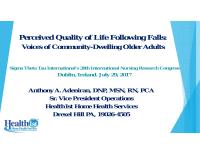A model of factors contributing to perceived abilities for health-promoting self-care of community-dwelling Thai older adults
View File(s)
Visitor Statistics
Visits vs Downloads
Visitors - World Map
Top Visiting Countries
| Country | Visits |
|---|
Top Visiting Cities
| City | Visits |
|---|
Visits (last 6 months)
Downloads (last 6 months)
Popular Works for Malathum, Porntip P. by View
| Title | Page Views |
|---|
Popular Works for Malathum, Porntip P. by Download
| Title | Downloads |
|---|
View Citations
Citations
The purpose of this descriptive correlational study was to examine factors contributing to perceived abilities for health-promoting self-care of community-dwelling Thai older adults. An integration of selected concepts from Orem's (1995) self-care theory and Bandura's (1997) self-efficacy theory is established to generate a conceptual model for this study. The study variables included age, education, perceived family support, perceived friend support, chronic health problems, functional ability, perceived health status, and perceived abilities for health-promoting self-care.
A survey-interview method was used for data collection. Perceived family support, perceived friend support, chronic health problems, functional ability, perceived health status, and perceived abilities for health-promoting self-care were measured by the Family APGAR Questionnaire, the Friend APGAR Questionnaire, the Chronic Health Problem Checklist, a composite on the Modified Barthel ADL Index and the Chula ADL index, the Self-Rated Health Scale, and the Self-Rated Abilities for Health Practices Scale, respectively. Stratified random sampling, based on age and gender, was employed to recruit a sample of 211 older adults living in rural areas in Thailand. Pearson's product-moment correlation coefficient was used to examine the relationships among the study variables. All hypothesized relationships were supported except for the relationship between age and chronic health problems and between age and perceived health status.
The hypothesized model was tested by path analysis through the EQS6 program. The initial hypothesized model did not fit the data, and so was modified until the goodness-of-fit indices were adequate (>.90). The robust comparative fit index (robust CFI = 1) indicated that the final modified model fit the data well. In summary, five exogenous variables in the final modified model (age, education, perceived family support, perceived friend support, and chronic health problems) contributed to perceived abilities for health-promoting self-care, directly and/or indirectly through two mediating variables (functional ability and perceived health status). Mediating variables in the model also contributed to perceived abilities for health-promoting self-care. Sixty-one percent of the total variance in perceived abilities for health-promoting self-care was explained by all study predictors. Using the multisample structural equation modeling approach to test the modified model across groups, gender differences were not found in this study.
This dissertation has also been disseminated through the ProQuest Dissertations and Theses database. Dissertation/thesis number: 3034979; ProQuest document ID: 304721295. The author still retains copyright.
This item has not gone through this repository's peer-review process, but has been accepted by the indicated university or college in partial fulfillment of the requirements for the specified degree.
| Type | Dissertation |
| Acquisition | Proxy-submission |
| Review Type | None: Degree-based Submission |
| Format | Text-based Document |
| Evidence Level | Descriptive/Correlational |
| Research Approach | Quantitative Research |
| Keywords | Older Adults; Thailand; Self-Care; Rural Areas |
| Grantor | The University of Texas at Austin |
| Advisor | Acton, Gayle J.; Stuifbergen, Alexa K.; Fouladi, Rachel T.; McDougal, Graham J. |
| Level | PhD |
| Year | 2001 |
All rights reserved by the author(s) and/or publisher(s) listed in this item record unless relinquished in whole or part by a rights notation or a Creative Commons License present in this item record.
All permission requests should be directed accordingly and not to the Sigma Repository.
All submitting authors or publishers have affirmed that when using material in their work where they do not own copyright, they have obtained permission of the copyright holder prior to submission and the rights holder has been acknowledged as necessary.
Related items
Showing items related by title, author, creator and subjects.
-
The relationships among social support, spiritual well-being, commitment and health-promoting behaviors in older adults
Boland, Clara S.Study purpose was to examine relationships among personal factors, social support, spiritual well-being, commitment and health-promoting behaviors in three elderly age groups. Pender's revised Health Promotion Model (HPM) ... -
Factors associated with psychotropic drug use among community-dwelling older persons: A review of empirical studies
Voyer, Philippe; Cohen, David; Lauzon, Sylvie (BioMed Central Ltd, 2004-08-13)In the many descriptive studies on prescribed psychotropic drug use by community-dwelling older persons, several sociodemographic and other factors associated with drug use receive inconsistent support. -
A study of the health-promoting behavioral effects of an exercise educational intervention in adult diabetics
Wisnewski, Charlotte A.The purpose of this study was to investigate if using a health promotion approach when teaching adult diabetics the importance of exercise would have a positive effect on the healthy behaviors in which they engage and ... -
Perceived quality of life following falls: Voices of community-dwelling older adults
Adeniran, Anthony A. (2017-07-25)The purpose of the study was to document the voices of community-dwelling older adults’ perceived quality of life following the experience of falls. -
Depressive symptom and its predicting factors among community-dwelling older adults with knee osteoarthritis
Aree-Ue, SuparbTo learn about prevalence of depressive symptom among Thai older adults with knee osteoarthritis and to understanding the predictive factors of depressive symptom among community-dwell older adults with knee osteoarthritis.





